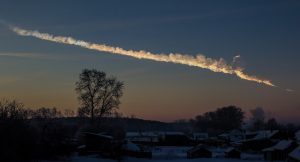“Don’t Look Up”, directed by Adam McKay and released in December 2021, follows the story of 2 astronomers who discover an approaching comet that they believe will destroy the Earth. Upon its release resurfaced an unsettling question; what are the odds of an asteroid striking Earth leading to mass extinction, and what actions can we take?
Encountering NEOs: Near-Earth Objects
Near-Earth objects are what scientists identify as asteroids or comets that have been nudged from the main asteroid belt into the inner solar system. The NEOWISE project is one of many ongoing operations tracking and predicting the orbital paths of NEOs to determine if they have the potential to impact Earth. The spacecraft used in this project detects NEOs by the infrared wavelengths they emit as a result of being warmed by the Sun and gathers data regarding the objects’ size and compositions.
Source: NASA Jet Propulsion Laboratory
Famously known for the Cretaceous extinction which wiped out the dinosaurs, asteroid collisions with the Earth are not uncommon. Harmless small rocks routinely enter Earth’s atmosphere and are burned up due to the immense heating caused by friction. However, complications arise when objects larger than roughly 25 meters strike Earth. In 2013, an asteroid about 20 meters in diameter entered Earth’s atmosphere above the city of Chelyabinsk, Russia. The asteroid exploded before reaching the Earth’s surface, releasing energy equivalent to 30 times that of a nuclear bomb. The event injured over 1600 people and caused estimated infrastructure damage of 33

Trail of Chelyabinsk meteor taken at a distance 200km away moments after the explosion. Image Credit: Alex Alishevskikh
million USD. While encounters with NEOs large enough to cause regional damage only occur every few centuries to millennials, and civilization-threatening objects once every few million years, the environmental and human endangerment of such impacts is great enough for scientists to push for planetary defence operations.
Planetary Defence Strategies
Planetary defence strategies to prevent encounters with hazardous NEOs are still being developed and tested today. NASA’s Double Asteroid Redirection Test (DART), launched on November 24, 2021, is the world’s first demonstration of the kinetic impactor technique involving the deliberate crashing of the spacecraft into an object. Upon reaching the targeted moon of asteroid Didymos A in September 2022, the transfer of momentum generated from the impact of the spacecraft should change the moon’s orbit enough to redirect its path. If successful, scientists hope to implement this technique to divert threatening NEOs away from the Earth in the case of such future discoveries.
Source: JHU Applied Physics Laboratory
The use of a gravity tractor could act similarly to divert the path of a NEO. This theoretical spacecraft would steer close enough to a NEO where a small but significant attraction with the spacecraft would slowly pull and change the NEO’s orbital path. Other methods involving blowing up NEOs with a powerful laser or simply evacuating the predicted impact areas have also been discussed, however, further research is required.
Should We Be Concerned?
Ultimately, the chances of an asteroid wiping out the human race is arguably infinitesimal. Yet planetary defence remains crucial to protecting our planet as encounters like the Chelyabinsk meteor remind us that even relatively small NEOs can cause significant damage.
Written by: Joanne Kit
